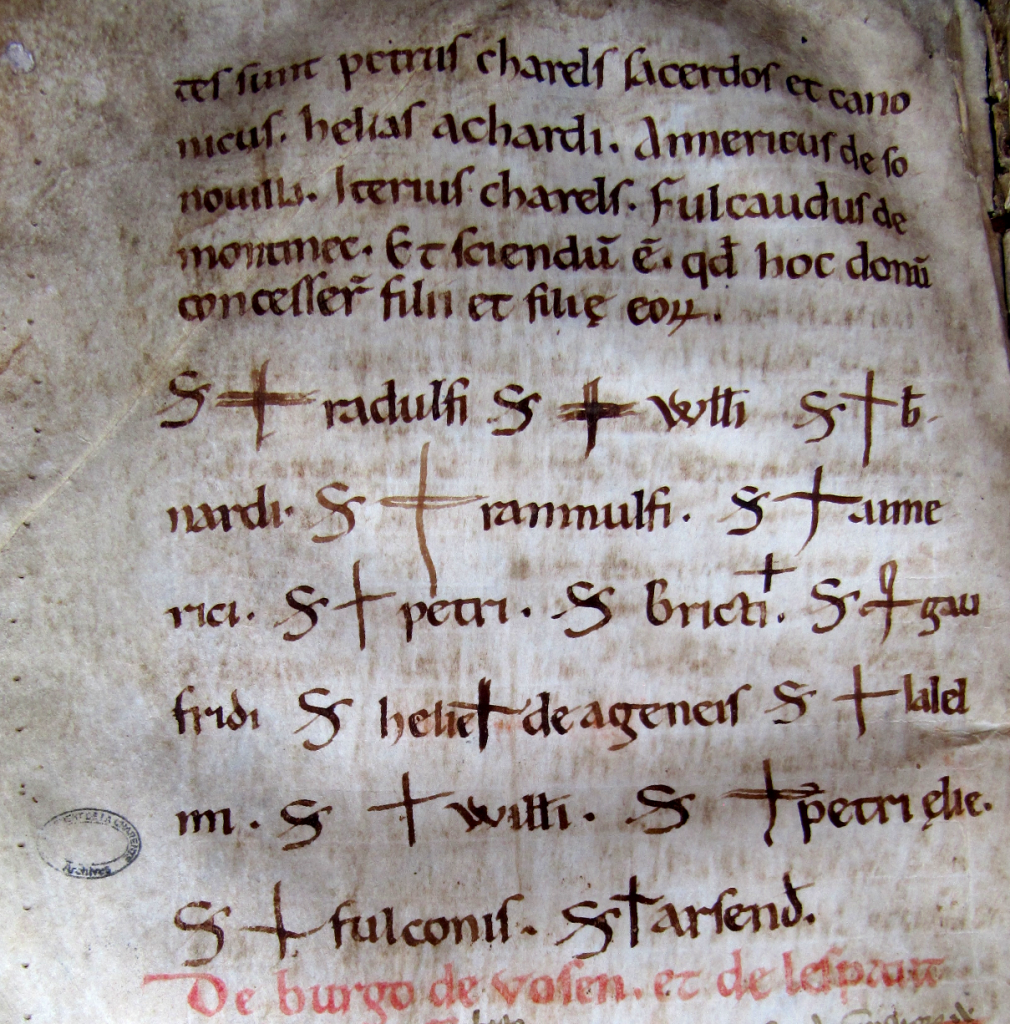Michael F. Webb
(Independent Scholar)
“By Our Own Hand: Cross-Signs in the Cartularies of Angoumois”
Abstract of Paper
Intended To be presented at the 55th International Congress on Medieval Studies [CANCELLED]
(Kalamazoo, 2020)
Rescheduled for the 56th International Congress on Medieval Studies
(Kalamazoo, 2021)
Session I of II on
“Seal the Real: Documentary Records, Seals, and Authentications”
Part I: “Signed & Sealed”
Sponsored by the Research Group on Manuscript Evidence
Organized by Mildred Budny
2020 Congress Program
2021 Congress Program Planning
[Published on 10 March 2020, with an Update on 17 March 2020 reporting the Cancellation of the Congress as a whole,
and with an Update on 19 November reporting the Rescheduling for the 2021 Congress]
*****
Abstract
When the religious institutions of Angoumois, just as their counterparts in much of western France during the twelfth century, received donations of property and rights from donors, they drew up charters to describe and complete the agreements. Wax seals would sometimes be attached to the documents, but often the actors and witnesses would make a cross-sign on the charter next to their names, which had been written by scribes. During this same period, the region’s religious institutions, also like those in many other regions, copied and arranged (and often manipulated) charters into compilations that historians now call cartularies. Scholars have always understood cartularies as compilations of copies.
Three twelfth-century cartularies from Angoumois, however, contain cross-signs of the signatories themselves: these were not marks copied out by the scribes who composed the rest of the text. The cartulary of the cathedral church of Angoulême contains the most examples, almost two dozen charters, that had these cross-signs autographed by those who donated to and settled disputes with the church. (See Figure 1.) The canonry of Cellefrouin, located in the northeastern corner of the diocese of Angoulême, produced a roll cartulary in the early twelfth century. While a portion was written all at once by one hand, it was later added to by others, and amid these additions are charters that were signed by the signatories. The cartulary of the monastery of Saint-Cybard, situated just outside the walls of Angoulême, also contains two examples where people signed in the cartulary itself, and includes an explicit description of signing in a book.
Considering that this was an extremely unusual practice — I know of no other examples of signed charters in medieval French cartularies — I first support my claim that these are indeed cross-signs made by people entering into agreements with these religious institutions and witnesses. Aspects such as the gaps between the main body of the charter and the names and crosses of the signatories, along with the often-shakily drawn crosses, directly mirror the cross-signs made in stand-alone charters. These charters must be considered originals even if there were other copies made simultaneously or before the texts in the cartulary. This undermines the common definition of what a cartulary is and what function it served.
I then explore the significance of this practice by attempting to piece together the processes involved in signing documents in cartularies. How did it differ from a transaction that was finalized by a stand-alone charter? As the use of seals in stand-alone charters became more common, why bother to make cross-signs in these cartularies, where no seals could be attached? That the act of signing in a cartulary was used in place of or in addition to a standard stand-alone charter suggests that the symbolic value of using a large book or long roll had its benefits. The signing of a document in a cartulary added another layer of meaning, compared to signing a stand-alone charter, by placing a donor’s gift side-by-side with many others, some dating back hundreds of years.
*****
Figure 1. Angoulême, Archives départementales de la Charente G330, fol. 93v. Examples of cross-signs made by actors and witnesses in the cartulary of the cathedral church of Angoulême between 1149 and 1159.

Angoulême, Archives départementales de la Charente G330, fol. 93v.
*****
